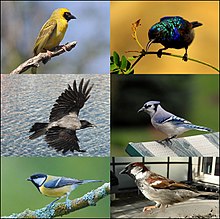Passerine
| Passerines Temporal range: Eocene-Recent, 52.5–0 Ma |
|
|---|---|
 |
|
| Clockwise from top right: Palestine sunbird (Cinnyris osea), blue jay (Cyanocitta cristata), house sparrow (Passer domesticus), great tit (Parus major), hooded crow (Corvus cornix), southern masked weaver (Ploceus velatus) | |
| Song of a purple-crowned fairywren (Malurus coronatus) | |
| Scientific classification | |
| Kingdom: | Animalia |
| Phylum: | Chordata |
| Class: | Aves |
| Clade: | Psittacopasserae |
| Order: |
Passeriformes Linnaeus, 1758 |
| Suborders | |
|
and see text |
|
| Diversity | |
| Roughly 100 families, around 5,400 species | |
and see text
A passerine is any bird of the order Passeriformes, which includes more than half of all bird species. A notable feature of passerines compared to other orders of Aves is the arrangement of their toes, three pointing forward and one back, which facilitates . Sometimes known as perching birds or, less accurately, as songbirds, the passerines form one of the most diverse terrestrial vertebrate orders, with over 5,000 identified species. It has roughly twice as many species as the largest of the mammal orders, the Rodentia. It contains more than 110 families, the second-most of any order of tetrapods (after Squamata, the scaled reptiles). The passerines contain several groups of brood parasites such as the viduas, cuckoo-finches, and the cowbirds. Most passerines are omnivorous, while the shrikes are carnivorous.
The names "passerine" and "Passeriformes" are derived from Passer domesticus, the scientific name of the eponymous species (the house sparrow) and ultimately from the Latin term passer for Passer sparrows and similar small birds.
The order is divided into three suborders, Tyranni (suboscines), Passeri (oscines), and the basal Acanthisitti. Oscines have the best control of their syrinx muscles among birds, producing a wide range of songs and other vocalizations (though some of them, such as the crows, do not sound musical to human beings); some such as the lyrebird are accomplished imitators. The acanthisittids or New Zealand wrens are tiny birds restricted to New Zealand, at least in modern times; they were long placed in Passeri; their taxonomic position is uncertain, although they seem to be a distinct and very ancient group.
...
Wikipedia
